Penguins are one of the largest birds on earth. It is time we appreciate them by securing their future!
They are cute waddlers, swift swimmers, and occasional movie stars (Happy Feet, anyone?). Penguins are flightless birds and are native to some of the harshest, coldest, and driest regions of the earth in the Southern Hemisphere.
Globally, 25th April is celebrated as World Penguin Day. Surprisingly, there’s a lot to learn about the penguins. In this article, know all about the different species of penguins and where they live. Be sure to also scroll through some gorgeous photos and some truly mind-boggling facts about the penguins. And last, make sure you get your family and friends together to acknowledge and honour these majestic birds!
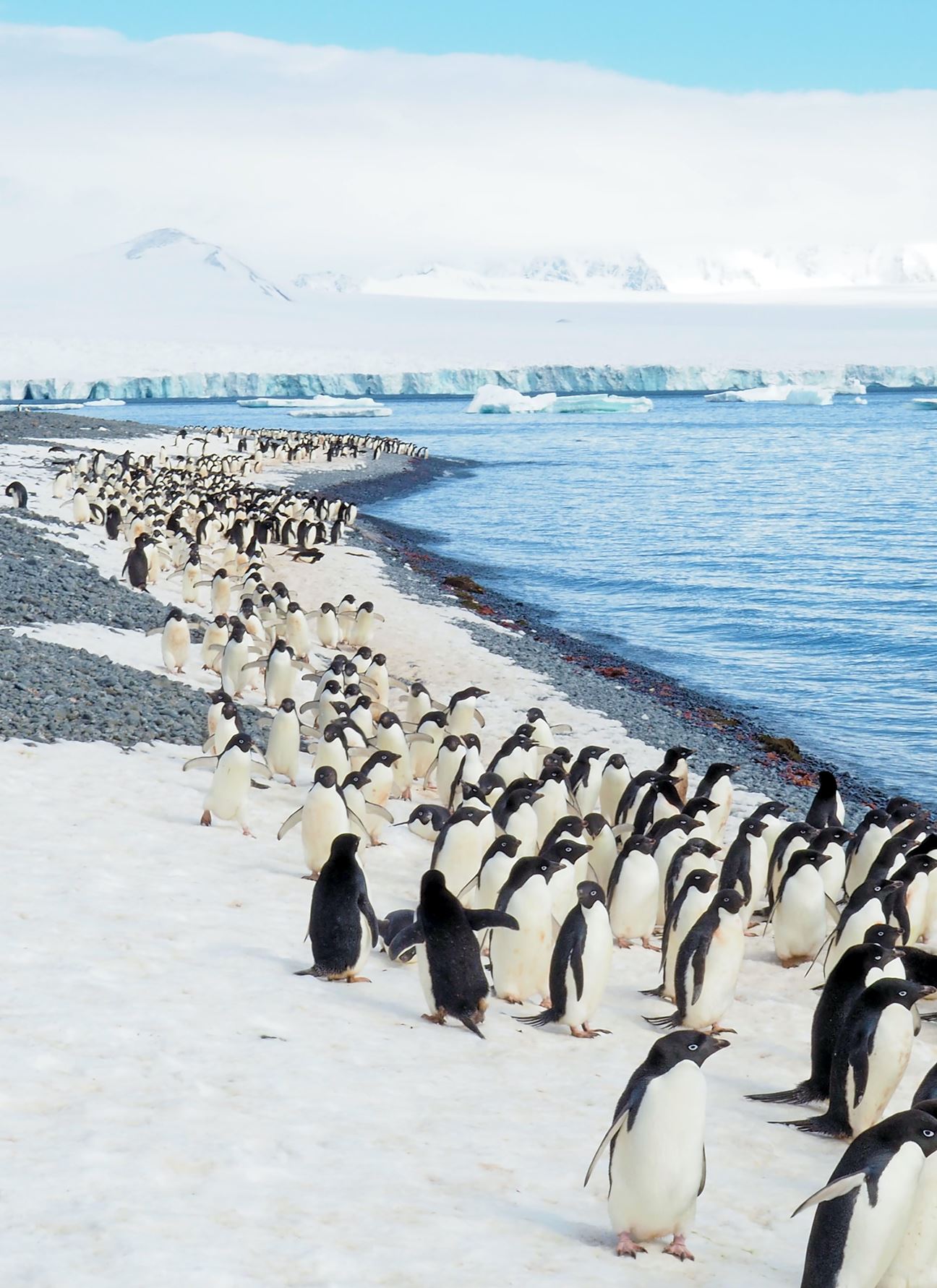
Adélies marching at Brown Bluff, Antarctica
History of World Penguin Day
Researchers at the McMurdo Station, an American research centre on the Ross Island observed that the native-Antarctican Adélie penguins begin their annual northern migration around 25th April each year. And so, to celebrate this event, they founded World Penguin Day. But this day is not limited to just celebrating the Adélie penguins. Rather, it celebrates and highlights all the 18 species of penguins found all over the globe.
Penguin habitats are directly impacted by climate change and the subsequent shrinking of sea ice. This has resulted in some penguin species deemed ‘endangered or vulnerable' by the International Union for Conservation of Nature (IUCN). Penguin lovers take this day as an opportunity to amplify the plight penguins are facing, and to work on ways to protect the sea and reduce pollutions.
Know Your Penguins!
Scientifically, penguins belong to the bird family Spheniscidae. There are a total of 18 penguin species found all over the world. And yet, many of them are not easily recognizable. The largest penguin is the Emperor Penguin, standing tall at 1.1 metres and weighing over 40 kilograms. The smallest, on the other hand, the Little Penguin, grows not over 16 to 18 inches and weighs around 1 kilogram.
Penguin bodies taper towards both ends and are best adapted for swimming. Their heads are large, with rather shorter necks. The webbed feet help them swim and give them an upright posture when walking on land. The body is elongated with a counter-shaded colour pattern - white on the ventral surface and black on the dorsal surface. The colouration and marking vary as per different species.
Here is a round-up of some of the penguin species from around the world:
These cute but feisty penguins are named after the Adélie Land, a French-claimed area in Antarctica. Their bodies are mid-sized and compact. A layer of fat under the skin provides insulation. They have a distinctive white ring surrounding the eyes and their bills are red. While a bit clumsy, an aggressive penguin is known to slap away its potential predator using his flippers. Their characteristic 'tuxedo' look makes them look like they are dressed to impress. With an estimated population of over 5 million, the Adélie Penguins are the most southerly penguins of Antarctica. These penguins migrate to the north at the onset of harsh winter and arrive in the south early in the summer months.
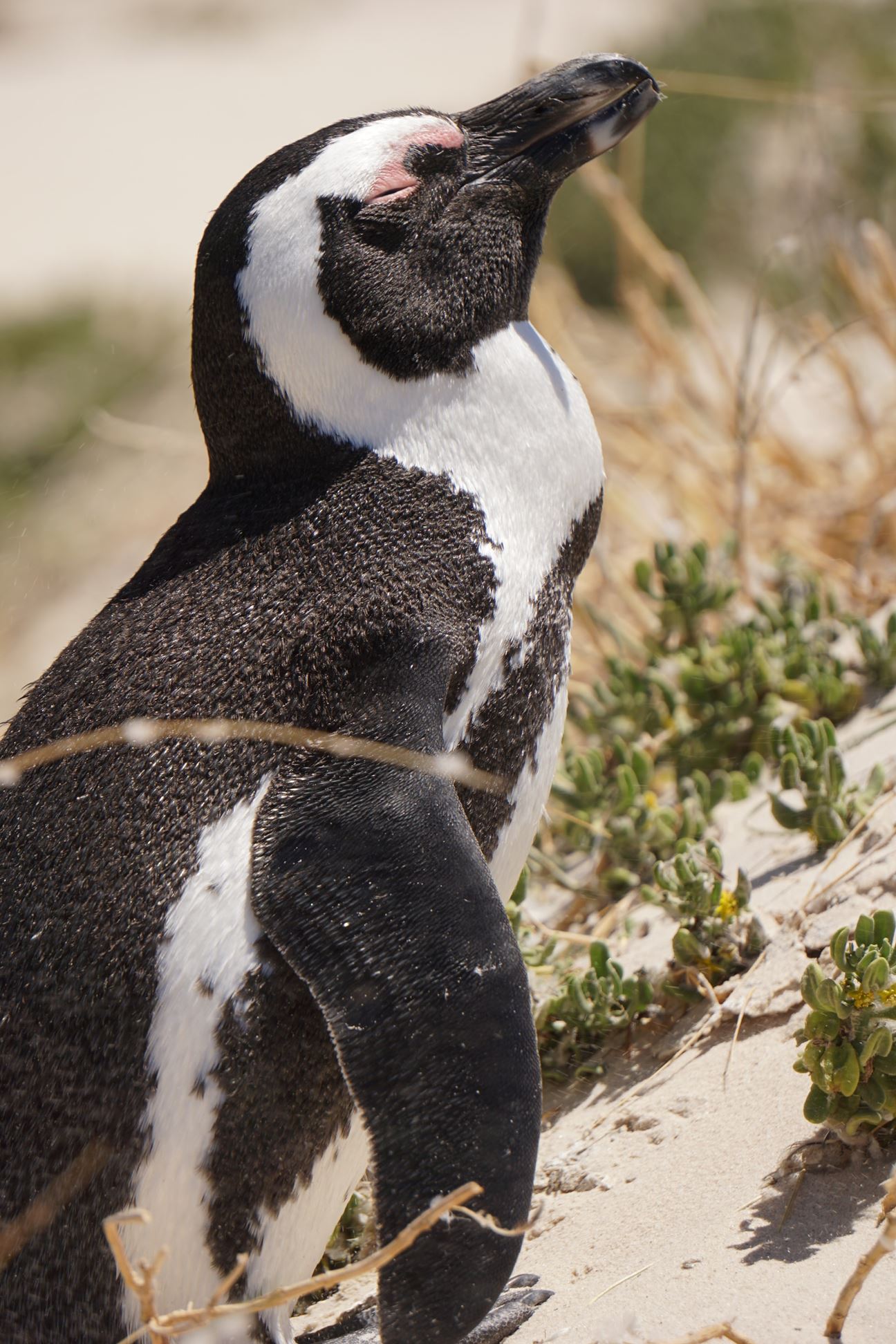
Also known as the South African Penguins or the Cape Penguins, these penguins are the only species that live on the African continent. They are relatively small and have a distinctive pink patch above their eyes. The African Penguins live on one of the most popular attractions of South Africa - the Boulders Beach. During an ecstatic display of emotions, these penguins are known to emit a loud donkey-like braying sound which has earned them the nickname “jackass.” Did you know that the African Penguins mate for life? Both the male and female penguins are known to share parenting duties. Unfortunately, the population of the African Penguins is on a decline - with less than 20,000 breeding pairs in the wild.

The largest of the penguins, the Emperor Penguins live along the coastlines of Antarctica. Fully grown adults are taller than 1 metre in height and can weigh between 20 to 45 kilograms. They are also the world’s deepest diving birds and can dive as deep as 550 metres in search of food. Wild Emperors are coloured in signature black-and-white and have patches of orange and yellow on their head and neck. The global population of the Emperor Penguins declined by as much as 50 per cent between 1950 and 2000. And today, these penguins are considered near-threatened species.

They grow just 20 inches tall and are the second smallest of all the penguin species. The Galápagos Penguins, as the name suggests, live on the Galápagos Island - far away in the Pacific Ocean. They are the northernmost settled penguins and the only ones to live on the equator. They are also the only penguins to set foot in the northern hemisphere. The unique adaptation techniques that help them survive the tropical climate have been the topic of research for many years. Globally, just about 1,000 breeding pairs remain in the wild - listing them as endangered.
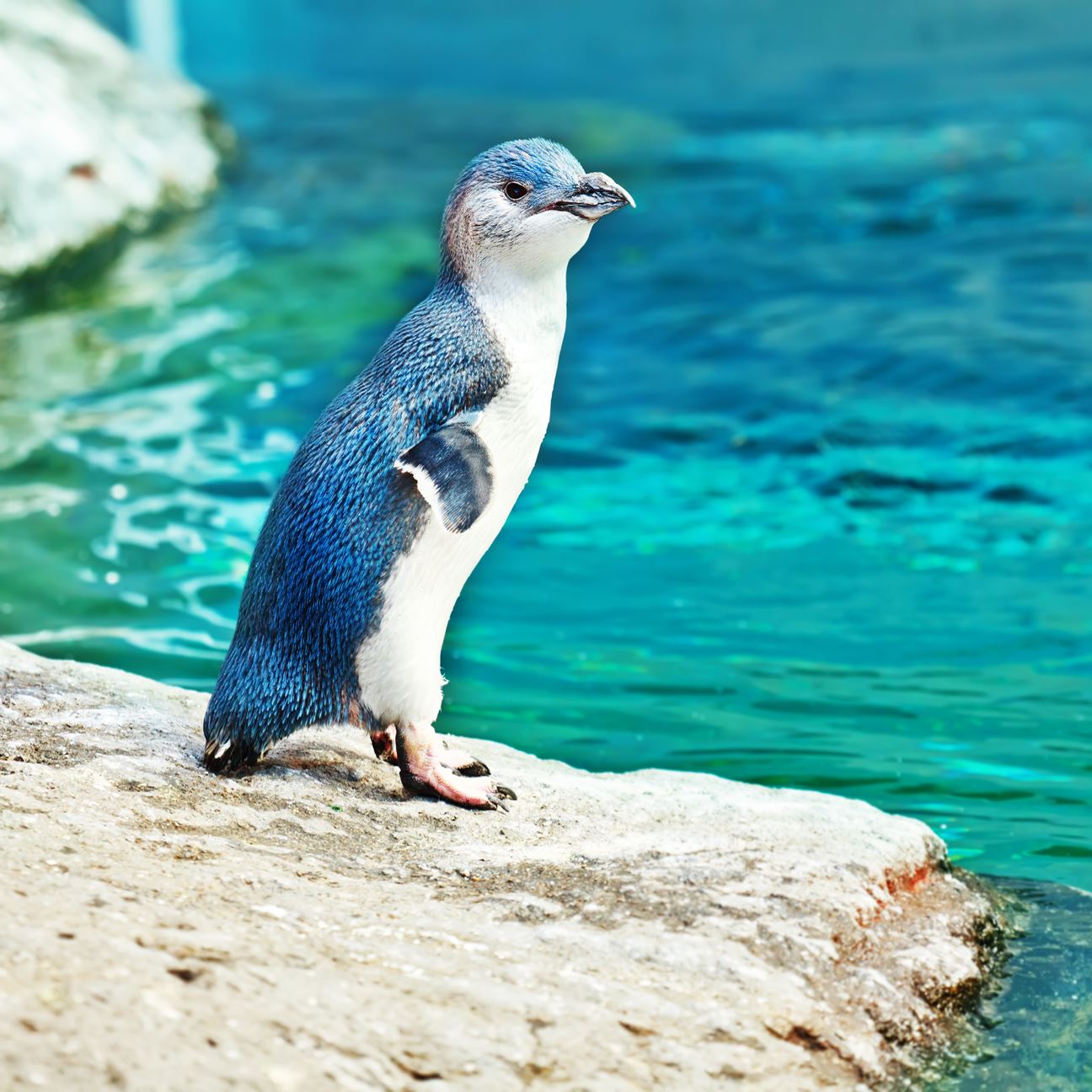
The Little Blue Penguin, or Little Penguins, is the smallest of all the penguin species. A fully grown adult penguin weighs as little as 1 kilogram. Their appearance is delicate and the distinctive bright blue-grey plumage makes these penguins unique among their counterparts. Little Blue Penguin colonies are found on the islands of New Zealand, Australia, and Tasmania. These small penguins are nocturnal and are very noisy at night. They are aggressive when provoked and can even attack violently when chasing away the intruders.
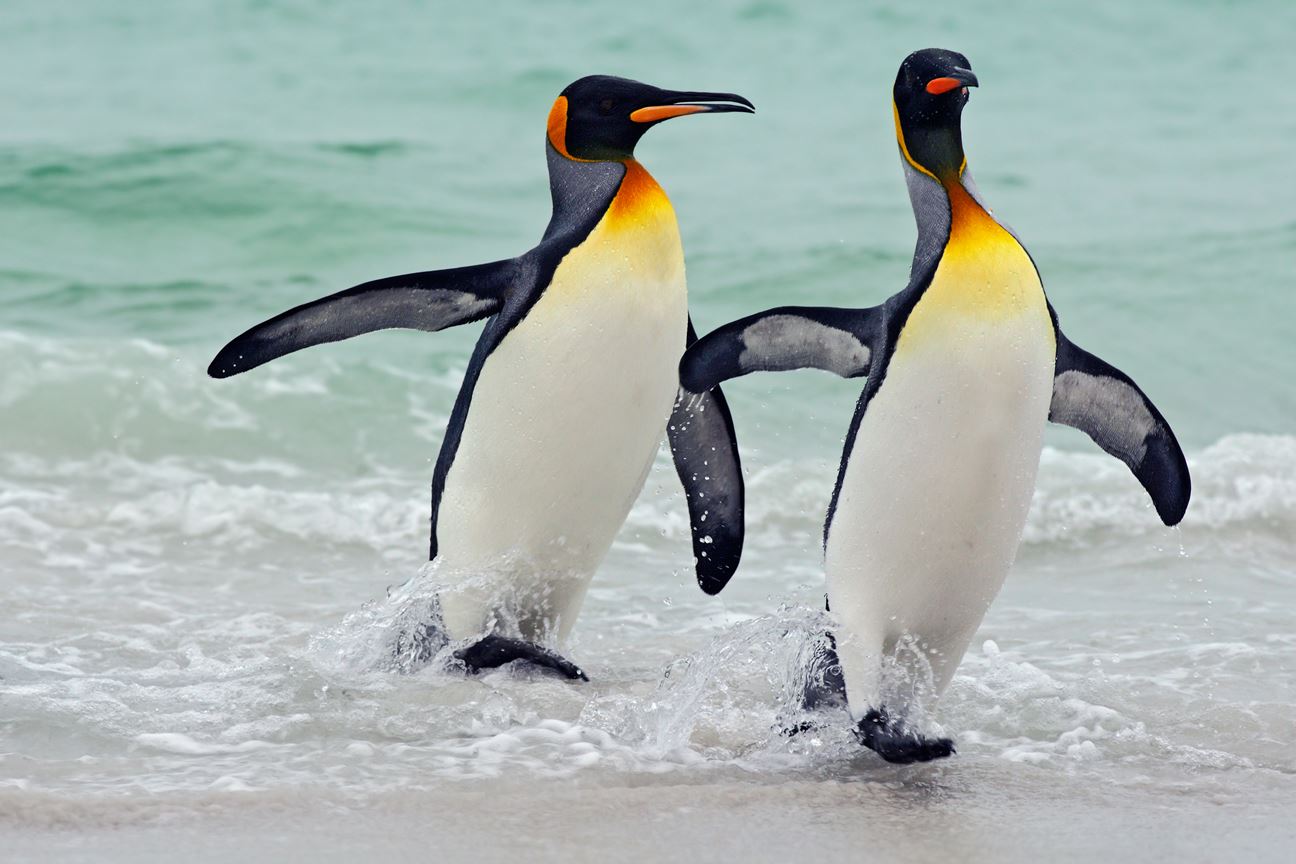
King Penguins are the second largest penguins in the world - next to the Emperor Penguin. These penguins are still tall and grow up to the height of approximately 95 centimetres (0.95 metres) as full-grown adults. They are mostly found on the sub-Antarctic islands and peninsulas and prefer beaches that offer easy accessibility to the sea. King Penguins have a unique colouration - a bright orange, tear-shaped patch on each side of their head that extends to their upper chest. Of all the penguin species, the King Penguins have the longest breeding cycle - lasting between 14 to 16 months.
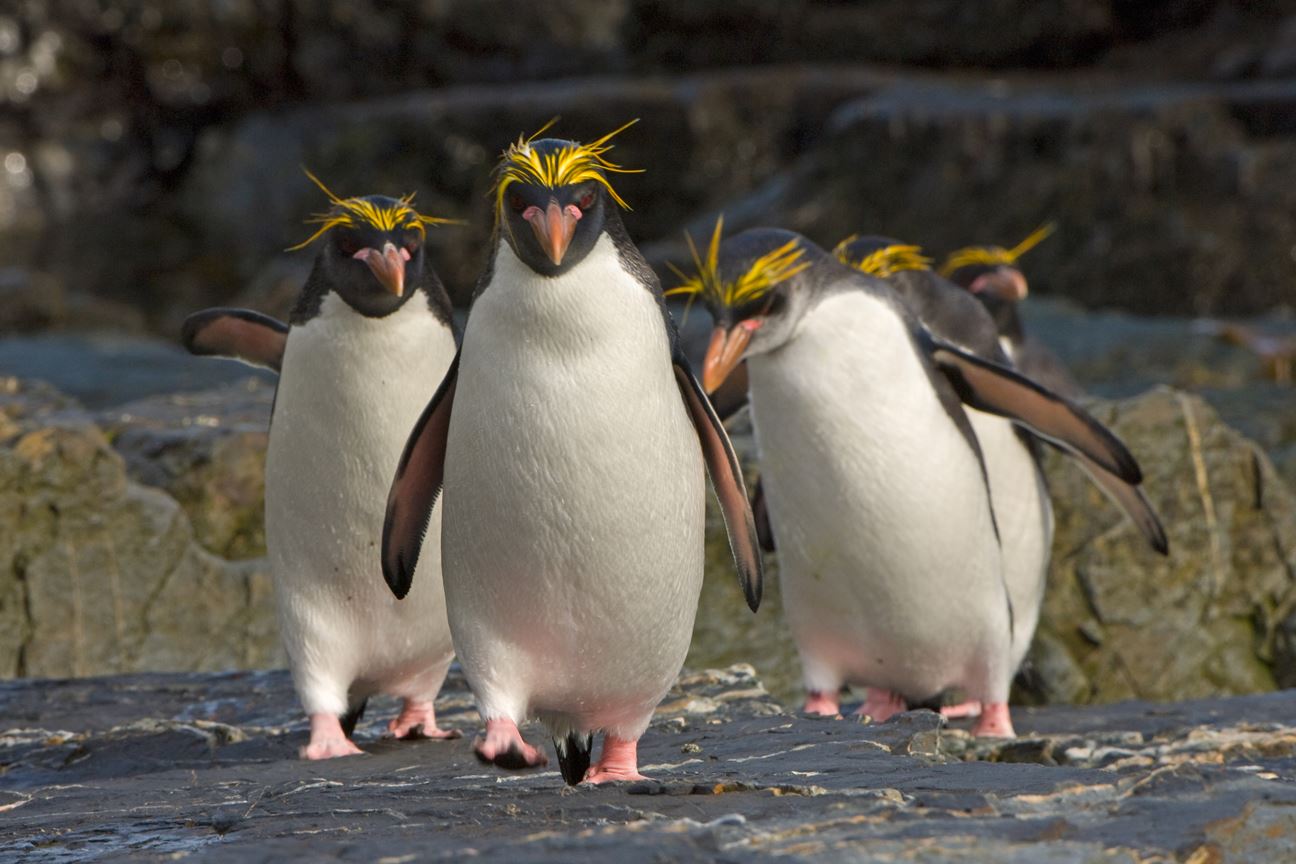 Macaroni Penguins on their return from the winter at sea
Macaroni Penguins on their return from the winter at sea
The Macaroni Penguins are amongst the most populous of all the penguin species - with an estimated 9 million breeding species in the wild. They are mainly found in areas from the Subantarctic to the Antarctic Peninsula where they forage for food that includes fish, krill, crustaceans, and squid. These penguins are named after their bizarre macaroni-like orange tufty plumes that they have for eyebrows. Their massive colonies see hundreds of thousands of penguins along the hillsides and rocky cliffs where they also prefer to nest.
Where do Penguins Live?
Almost all penguin species are native to the Southern Hemisphere. Penguins are cold-adapted but are not limited to cold climates. Rather, most of them live in temperate zones. The northernmost species lives on the Galapagos Island, while the southernmost species of penguins live on the continent of Antarctica. There are no penguins in the Arctic. Here are some places penguins call their homes:
- Antarctica - The coldest continent is also the one with the largest penguin population. However, only two species - the Adélie Penguins and Emperor Penguins live here all year round. Meanwhile, the Chinstrap, Macaroni, and Gentoo penguins will split their time between the Antarctic peninsula and Antarctic islands to the north.
- Galápagos Islands - The volcanic islands of Galápagos are nothing short of a live animal laboratory. These islands host a single species of penguins - the Galápagos Penguins. Given its tropical climate, the penguins here are known to spend most of their time in the caves and crevices to avoid the heat.
Falkland Islands - Situated in the southern Atlantic Ocean, some 300 miles east of the coast of South America, the Falkland Islands can be called the capital of the penguin world. King, Magellanic, Rockhopper, Gentoo, and Macaroni penguins - a total of five penguin species live and nest here. The islands and their sandy beaches and cliff-lined coastlines host more than a million penguins.
Argentina - Given its vast expanses and chilly South Pacific climate, Argentina and Patagonia is home to the mid-sized Magellanic Penguins.
Australia and New Zealand - The smallest of all the penguins - the Little Penguins are found in the island nation of Australia. While Australia is largely arid, these penguins have made the southern coast of Australia their home - where the climate is cool and the water even cooler.
New Zealand, on the other hand, is home to four penguin species. These include Fiordland Crested, Yellow-Eyed, Little, and Snares Penguins. The Yellow-Eyed penguins found here have the second-lowest penguin population - an estimated 4,000 individuals in the wild.
- South Africa - The southernmost nation of Africa became home for the penguins as recently as 1980. Before that, the African Penguins were found on various islands along the coast of southern Africa - from Mozambique on the east to Angola on the west. Researchers established two colonies on the mainland beaches near the capital Cape Town. The Boulders Penguin Colony is today one of the top attractions of South Africa.
Fun Penguin Facts
We think we know it all about the penguins - they are flightless birds, clumsy walkers, and live in colder regions of the world. But did you know penguins have knees too? They are just hidden deep under their feathers. Let us look at a few more fun penguin facts:
- As the mating season approaches, the Gentoo Penguins are known to bring gifts for their lady loves! A male will find the smoothest looking pebble for his lady and if she likes the gift, she will place it in the nest as the two continue to build their home.
- Emperor Penguins are known to huddle in groups to keep warm during harsh winters. These huddles keep shifting and may not always be symmetrical. Though each penguin will maximize his body heat for the benefit of the group.
- Penguins can ‘fly’ underwater with seemingly no effort. Their feathers are small and bones solid, thus helping them overcome buoyancy and remain submerged underwater for longer periods. Most penguins swim at a speed of 5 to 10 kilometres/hour. The fastest of them all, the Gentoo can reach a whopping speed of 35 kilometres/hour!
- Penguins pant to combat hyperthermia. As seen earlier, most penguins live in temperate zones and hence thermoregulation adaptations kick in. Penguins will pant like dogs to evaporate moisture from the body and burn the excess heat.
- Most penguins will stay with the same partner for many years. Before the arrival of the young one, both the male and female penguins will take turns to keep the eggs warm.
- Their tuxedos are not just for fashion. The distinctive colour combination helps them be camouflaged when swimming. While the white bellies match the bright-lit skies above, the black backs blend in the dark ocean waters.
All penguins experience moult where they lose all their feathers at once. Meaning, at least once a year, they will lose and regrow their feathers. During this period, penguins cannot swim and so cannot hunt for food. They will fatten themselves up and store enough food for the period of 2-3 weeks until all the feathers are replaced.
Interesting, isn't it? Through millions of years of evolution, penguins have adopted many remarkable adaptation and survival techniques. Their range of habitat very well proves that. Sadly, human activities are impacting their spaces too fast for them to cope. Today, over half the penguin species are in danger of going extinct. World Penguin Day is a great opportunity for all of us to help penguins live and continue to live the beautiful and inspiring life they deserve for many more years.